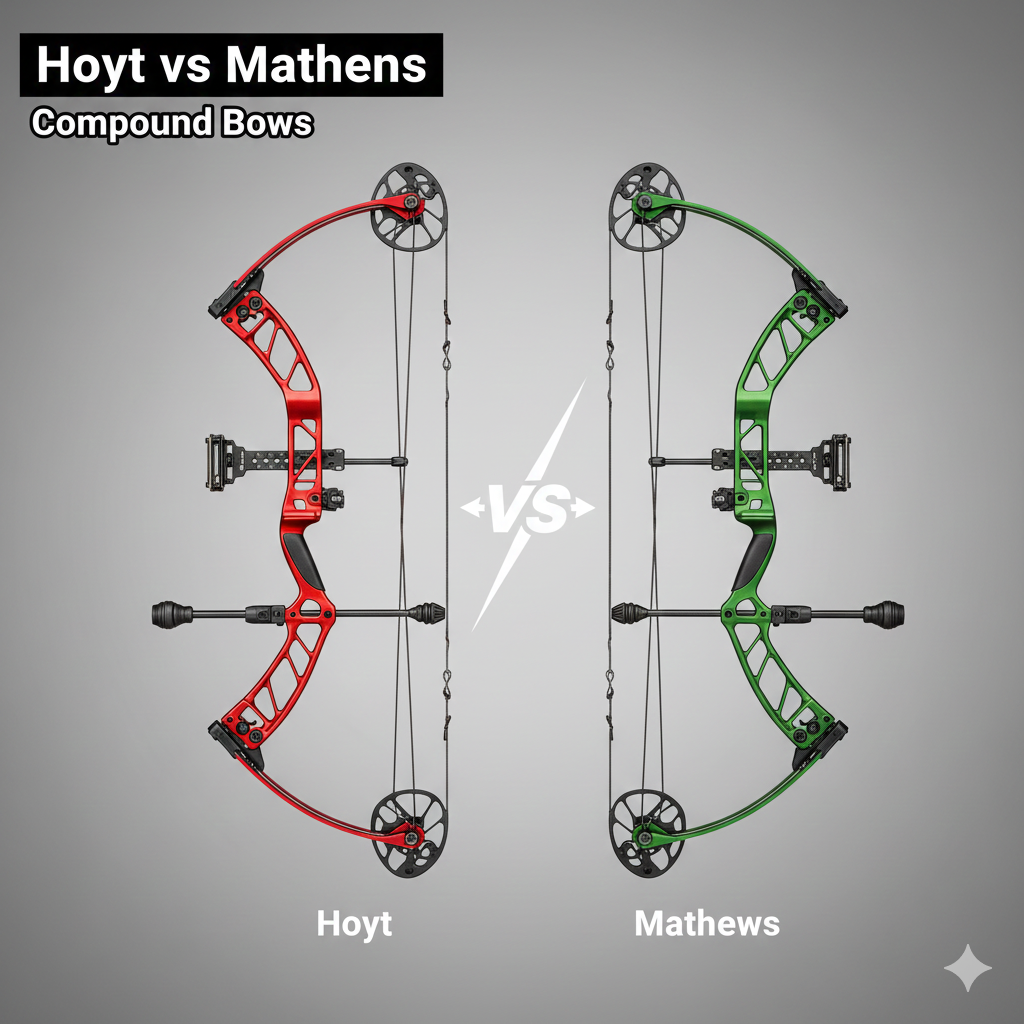Hoyt vs Mathews Compound Bows: A Detailed Comparison for 2025

The world of compound bows is filled with innovation, craftsmanship, and brand loyalty. Among all manufacturers, two names consistently stand above the rest Hoyt and Mathews. These companies have built devoted followings over decades, producing bows that dominate both the hunting fields and competitive archery circuits. The comparison between Hoyt and Mathews has become a classic debate that resurfaces every year, especially when new flagship models are released.
But if you’re trying to decide which brand is right for your shooting style, it can be overwhelming. Both offer premium features, precision engineering, and exceptional performance. To help you navigate this rivalry, this in-depth guide explores the history, performance characteristics, design philosophies, and real-world shooting experience of each brand.
Brand Identity and Design Philosophy
Although both Hoyt and Mathews produce high-performance compound bows, their philosophies and design priorities differ significantly.
Hoyt, founded in 1931, is one of the oldest and most respected names in archery. Their heritage is built on durability, engineering resilience, and high precision. Hoyt bows have a reputation for being tough, stable, and reliable—qualities that appeal strongly to target shooters and bowhunters who need equipment capable of surviving harsh environments and intense use. Hoyt approaches bow building with a performance-first mindset, emphasizing robust construction and advanced riser geometry.
Mathews, founded later in 1992, is driven by a different principle: smoothness, silence, and user-friendly performance. Every bow from Mathews reflects an obsession with comfort, balance, and quietness. Their design philosophy focuses on minimizing vibration, creating the smoothest possible draw cycle, and delivering consistent accuracy through simplicity. While Hoyt bows often feel like precision machines built for strength, Mathews bows feel refined, polished, and almost effortless to shoot.
These two identities shape everything the companies produce—and ultimately play a large role in determining which brand shooters prefer.
Build Quality and Craftsmanship
A major factor that separates Hoyt and Mathews is their riser construction. Hoyt is one of the only brands known for producing both aluminum and carbon risers at advanced engineering levels. Their carbon risers, in particular, are legendary for being lightweight, incredibly stiff, and resistant to temperature changes. Bowhunters who operate in cold weather environments appreciate that Hoyt carbon risers don’t hold cold like aluminum risers do. The bows feel solid in the hand, and this added rigidity contributes to long-range stability and accuracy.
Mathews, on the other hand, uses precision-machined aluminum risers that are renowned for their refinement and aesthetics. What Mathews may lack in carbon riser production, they more than make up for in flawless machining and finish quality. Their bows always look polished and premium, with smooth lines, ergonomic shapes, and advanced vibration-dampening built directly into the riser. While Hoyt leans into rugged strength, Mathews focuses on creating a bow that feels comfortable and controlled from the first draw.
Both brands offer exceptional craftsmanship but the tactile experience differs noticeably. A Hoyt bow feels solid, sturdy, and engineered to take abuse. A Mathews bow feels silky, balanced, and tuned for comfort.
The Draw Cycle Experience
The draw cycle is one of the most important factors in choosing a compound bow, and this is one area where differences between Hoyt and Mathews become immediately apparent.
Hoyt bows typically have what many shooters call a “performance-focused” draw cycle. They often start with a bit more resistance early in the draw, with a firmer transition into the valley and a strong, definitive back wall. Hoyt’s cam systems are designed to maximize power and energy transfer, which often gives their bows slightly more aggressive characteristics. For experienced shooters who prioritize speed, efficiency, and control, this type of draw cycle is ideal. It gives the archer a sense of authority over the bow—there’s power behind every inch of movement.
Mathews bows are the opposite. Their draw cycles are famous for being extremely smooth, with a steady, comfortable pull from start to finish. The valley is typically deeper, and the transition to full draw feels natural. This smoothness reduces shooter fatigue, especially during long practice sessions or full days in the treestand. Mathews’ cam systems, such as the Crosscentric cam and SwitchWeight System, are engineered to deliver maximum efficiency while maintaining a silky draw. The overall feeling is more forgiving and pleasant, appealing to hunters and archers who prioritize comfort over raw aggression.
If your shooting style leans toward power, urgency, and performance, Hoyt’s draw cycle may suit you better. But if you want comfort, smoothness, and a bow that feels effortless to hold at full draw, Mathews has the advantage.
Performance, Accuracy, and Consistency
When it comes to accuracy, both brands offer elite-level performance. However, the way they achieve this accuracy differs.
Hoyt bows often feel incredibly stable in the hand due to their construction and balance. The riser stiffness, the grip geometry, and the overall weight distribution contribute to a steady hold on target. Many competitive archers appreciate Hoyt’s ability to remain solid during the aiming process. For shooters who like a heavier bow with a rigid platform, Hoyt delivers world-class consistency. The bow almost feels like it guides the arrow along a fixed path.
Mathews bows excel in forgiving accuracy. Because they produce very little vibration and almost no after-shot hand shock, the shooter experiences minimal disruption during the shot cycle. This silence and smoothness translate directly into improved accuracy, especially for hunters shooting from awkward positions. Mathews bows give the shooter more margin for error, making them ideal for real-world hunting situations where form isn’t always perfect.
Both bows can be tuned to incredible precision, but the way they feel during the shot is what sets them apart: Hoyt is firm and commanding, while Mathews is gentle and controlled.
Vibration and Noise Control
If quietness is your top priority especially for bowhunting Mathews has long been considered the industry leader. Their bows feature advanced dampening systems integrated into the riser and limbs, creating a nearly shock-free experience. When a Mathews bow fires, the shot feels dead in the hand. The lack of noise and vibration boosts shooter confidence and minimizes the chance of startling game animals.
Hoyt has made major strides in vibration reduction, especially in their latest models, but there is still a noticeable difference between the brands. Hoyt bows generally have slightly more feedback in the hand. This doesn’t necessarily mean they’re loud far from it but Mathews bows are simply engineered to be as quiet as modern technology allows.
For hunters who require absolute stealth, Mathews remains the top choice.
Speed, Power, and Energy Output
Hoyt has a reputation for producing bows with strong speed ratings and impressive energy transfer. Their cam systems are built for performance, often delivering fast arrow speeds and high kinetic energy values. This makes Hoyt a strong choice for shooters targeting long distances or hunting larger game such as elk or moose, where arrow penetration is crucial.
Mathews bows deliver excellent speeds as well, but their design philosophy prioritizes efficiency and smoothness over pure speed. While they may not always top Hoyt in IBO ratings, their real-world arrow speeds are extremely consistent and reliable. Their shot efficiency with minimal wasted energy often translates into more accuracy and a smoother shooting process.
If hitting maximum speed is important to you, Hoyt usually has a slight edge. If you prefer efficiency and smooth energy distribution, Mathews may be the better fit.
Tuning and Adjustability
Both Hoyt and Mathews offer bows that can be tuned very precisely, but their systems differ.
Hoyt bows tend to require a bit more tuning knowledge. Experienced archers who enjoy fine-tuning their setup appreciate this because it allows them to dial in the bow perfectly. Once a Hoyt is tuned, it holds its tune extremely well, reflecting the bow’s mechanical stability.
Mathews bows are known for their ease of tuning. The SwitchWeight Cam System allows archers to change draw weights simply by swapping mods without compromising cam performance or requiring a bow press. This user-friendly approach makes Mathews a favorite for beginners and for hunters who want quick adjustments without deep tuning experience.
Which Brand Should You Choose?
Choosing between Hoyt and Mathews ultimately depends on your priorities as a shooter.
If you prefer a bow that feels powerful, rugged, and engineered for long-term stability, and if you enjoy fine-tuning your setup, Hoyt is the ideal choice. Their bows are built for shooters who want something that feels strong and authoritative in hand.
If you value comfort, smooth performance, quiet shooting, and forgiving accuracy, Mathews is the better fit. Their bows provide an unmatched shooting experience, especially for hunters spending long hours in the field.
Both brands deliver exceptional quality and craftsmanship. Your decision should be based on how you prefer a bow to feel, draw, and perform in your hands.
Conclusion
The debate between Hoyt and Mathews compound bows is one that will likely continue for years, and for good reason both brands sit at the very top of the archery industry. They deliver exceptional craftsmanship, cutting-edge technology, and shooting performance that far exceeds the needs of most hunters and target shooters. Yet, their differences are what make this comparison meaningful.






